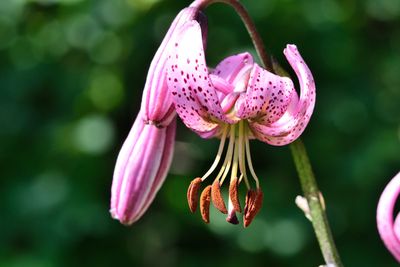Potted Martagon Lily Info
Martagon lily is also known as Turk’s cap, and this describes the lovely flowers nicely. They are smaller than Asiatic lilies, but many blossoms can grow on each stem. Although an average martagon lily will have between 12 and 30 lilies per stem, you’ll find some martagon plants with up to 50 flowers on a stem. So a potted martagon lily will require a large, substantial container. You often see martagon flowers in dark, rich shades, but they don’t have to be. Martagon lilies can be yellow, pink, lavender, pale orange, or deep, dark red. There is also a pure white variety. Some open into a gorgeous soft yellow- brown, freckled with dark purplish spots and dangling orange anthers. If you are considering planting martagon lily in a container, keep the ultimate size of the plant in mind. The stems are quite tall and slender and can rise to between 3 and 6 feet (91-180 cm.) tall. The leaves are whorled and attractive.
Care for Martagon Lilies in Pots
This lily species originated in Europe, and still can be found in the wild in France and Spain. The plants thrive in USDA plant hardiness zones 3 through 8 or 9. Only plant these bulbs in zone 9 on the north side of the house in the shade. In fact, all martagon lilies prefer a healthy dose of shade each day. The ideal mix for the plants is sun in the morning and shade in the afternoon. These are the most shade-tolerant of lilies. Like all lilies, container grown martagon lily requires soil with excellent drainage. Rich, dense soil will rot the bulbs. So, if you are putting martagon lilies in planters or pots, be sure to use appropriately light potting soil. Plant the bulbs into the well-worked soil, which should be slightly alkaline rather than acidic. It never hurts to add a little lime to the top of the soil when you are planting. Water as needed when the soil becomes dry to the touch. The use of a moisture meter is helpful or simply check with your finger, up to the first knuckle (about a couple inches or 5 cm.). Water when it is dry and back off when it’s still moist. Take care not to overwater, which will lead to bulb rot, and don’t allow the container to dry out completely.
